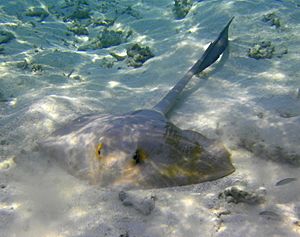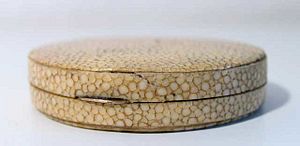Cowtail stingray facts for kids
Quick facts for kids Cowtail stingray |
|
|---|---|
 |
|
| Cowtail stingray off Marsa Alam, Egypt | |
| Conservation status | |
| Scientific classification | |
| Genus: |
Pastinachus
|
| Species: |
sephen
|
| Synonyms | |
|
|
The cowtail stingray (Pastinachus sephen) is a type of stingray found in warm ocean waters. It lives across the Indo-Pacific region. Sometimes, it even swims into freshwater places like rivers.
People also call this ray by other names. These include banana-tail ray, drab stingray, and fantail ray. Its most special feature is a large, flag-like flap under its tail. This flap is very noticeable when the ray swims.
Sadly, people catch many cowtail stingrays for their tough skin. This skin is used to make a special kind of leather called shagreen. Because so many are caught, their numbers are now decreasing.
Contents
Where Do Cowtail Stingrays Live?
The cowtail stingray lives in the warm, tropical waters of the Indo-Pacific. This huge area stretches from South Africa and the Red Sea all the way to Japan and Australia. It also includes islands like Melanesia and Micronesia.
These rays can live in both salt and fresh water. They are known to swim into estuaries (where rivers meet the sea) and even far up rivers. The cowtail stingray is the most common stingray found in fresh water in Southeast Asia. One was even found in the Ganges River, about 2,200 kilometers (1,367 miles) from the ocean!
You can usually find them on sandy bottoms. They live in coastal waters and near coral reefs. They can be found in water up to 60 meters (200 feet) deep.
What Does a Cowtail Stingray Look Like?
The body of the cowtail stingray is very thick and flat. It looks like a disk. This disk is a bit longer than it is wide. Its snout (nose) is wide and rounded. The eyes are very small and set far apart.
Its mouth is narrow. Inside, it has about 20 rows of unique, hexagon-shaped teeth in each jaw. There are also five small bumps, called papillae, on the floor of its mouth. The tail is wide at the base and gets thinner towards the end. It has a single venomous spine located far back on its tail.
The most unique part is the large flap under its tail. This flap is called the ventral tail fold. It can be 2 to 3 times taller than the tail itself. However, it doesn't reach the very tip of the tail.
The top of the ray's body is covered in tiny, rough scales called dermal denticles. These cover a wide area from its snout to its tail. When they are born, young rays are smooth. But they quickly grow these denticles. Older rays might have four small bumps in the middle of their body.
Cowtail stingrays are usually grayish-brown to black on top. Their underside is mostly white. The tail flap and tip are black. These rays can grow quite large. They can be up to 3 meters (10 feet) long and 1.8 meters (6 feet) wide. They can also weigh up to 250 kilograms (550 pounds)!
How Do Cowtail Stingrays Live?
Cowtail stingrays usually search for food alone. They eat many different things. Their diet includes bony fishes, crustaceans (like crabs and shrimp), and various types of worms and molluscs (like snails).
Bigger ocean animals hunt cowtail stingrays. These predators include different kinds of hammerhead sharks and other sharks. Even bottlenose dolphins sometimes prey on them. When a stingray feels threatened, it swims away at a 45-degree angle. This helps it get away quickly while still keeping an eye on the predator.
Like other stingrays, cowtail stingrays give birth to live young. This is called ovoviviparous reproduction. The babies grow inside the mother. They get food from a special "uterine milk" before they are born. Female rays give birth to young that are about 18 centimeters (7 inches) wide or more.
In some areas, like the Strait of Malacca, baby rays have been seen all year round. Young rays have pointier snouts than adult rays. Sometimes, adult rays swim with other fish like remoras or trevallies.
Resting in Groups
Scientists have watched cowtail stingrays in Shark Bay, Australia. They found that these rays go into shallow, sandy areas during high tide to rest. They usually rest for at least four hours.
When they rest, they often form small groups. This happens especially when it's hard to see, like in cloudy water or when it's dark. A typical group has three rays. Larger groups, up to nine, are rare.
These groups often arrange themselves in a "rosette" shape. Their tails point outwards in a circle. This is a clever way to protect themselves from predators. By forming a circle, they can see predators coming from any direction. Their tails also have special sensors that act as an early warning system. If a predator gets too close, the whole group will swim away together. This makes it harder for a predator to pick out just one ray.
Cowtail stingrays also sometimes rest with reticulate whiprays. This is probably because whiprays have longer tails. This might help them detect predators even better.
Cowtail Stingrays and People
The serrated spine on a cowtail stingray's tail can be dangerous. It's considered risky to handle them. Their long tail can even reach over their back to sting someone holding them from the front.
People catch some cowtail stingrays by accident while fishing for other things. Their meat is sold in markets. Their tough skin is also used to polish wood.
But the most important use of the cowtail stingray is for its skin. It's the main source of shagreen, also known as galuchat. This is a special type of leather. People have valued it for a long time. This is because the ray's skin has large, evenly spaced bumps. These bumps look like pearls after they are polished.
Since the 1990s, there has been a huge demand for shagreen around the world. It's used for many fashion items, from wallets to fancy pens. This has led to many cowtail stingrays being caught in Southeast Asia.
Stingrays grow slowly and live a long time. Because of this, scientists worry that catching so many rays is not sustainable. This could cause their populations to crash.
See also
 In Spanish: Raya de cola plumosa para niños
In Spanish: Raya de cola plumosa para niños





